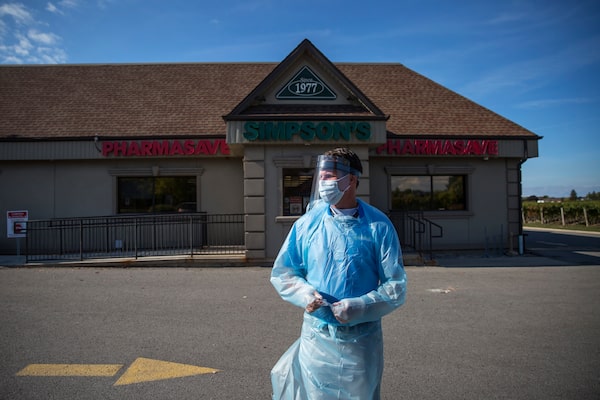
Pharmacist Sean Simpson poses outside of his pharmacy in Virgil, Ont., on Oct. 5, 2020. Simpson's pharmacy will be offering a drive through flu clinic this year.Tara Walton/The Canadian Press
Increased demand for the flu shot and physical-distancing requirements because of the COVID-19 pandemic are creating logistical challenges for health care providers administering the annual vaccine, leading to long lines and frustrated patients.
Heightened demand for flu vaccines was expected this year amid the coronavirus pandemic. Medical experts have expressed concerns about a “twindemic,” where a flu outbreak would overlap with COVID-19.
In the past few weeks, people have encountered long lines outside pharmacies and extra steps when booking online appointments, including screenings for COVID-19 symptoms. For many people, the walk-in flu shot is not an option this year.
With many family physicians shifting to virtual care and public-health guidelines making it difficult to run traditional flu clinics, health care practitioners are experimenting with new methods to immunize patients, such as drive-through clinics.
Trudeau blames cuts under Harper for Public Health Agency’s ills
“You can’t just drop in to a crowded drug store, and you can’t just go to your physician if your physician isn’t seeing patients,” said Bill VanGorder, chief policy officer for the Canadian Association of Retired Persons.
Canadians over 65 are typically advised to get a high-dose flu shot. Mr. VanGorder said that they’re hard to find if a person does not live in a long-term care home. This year, the federal government purchased the high-dose vaccine for long-term care residents in all provinces and territories.
“In many provinces, they’re finding that they’re not available, or they’re available in short supply,” he said. “We’ve talked with the suppliers and we’re told that what’s out there is out there and there isn’t going to be any more available.”
However, the Public Health Agency of Canada said in a statement that it does not expect any supply problems over all this year. The agency said provinces and territories have ordered about 13.9 million doses, 2.7 million more than they did at the same time in 2019. It expects the majority of deliveries to be completed by the end of October.
While supply may meet demand, health care providers are still facing challenges in administering the vaccine because of physical-distancing guidelines.
“You can’t have a walk-in flu clinic," said Allan Grill, a family doctor in Markham, Ont. "Fifty people show up at once, you can’t guarantee proper physical distancing to decrease the risk of transmission.”
Still, Dr. Grill said “family medicine is open for business,” even if waiting rooms are bare and many doctors have shifted to virtual care.
“Patients are being seen, there’s just more triage than before,” he said. “There’s definitely more planning this year, but family physicians are banding together, they’re organizing to give flu shots."
Patients can book appointments online, and are screened before receiving a flu shot. Dr. Grill said doctors in his region are setting up an outdoor drive-through clinic, a model he has seen used for other vaccines amid the pandemic.
Ryan Doherty, president and founder of Empower Health, a company that helps people access health care services, also sees potential in drive-through clinics, and expects them to pop up across the country in coming weeks.
This year, his company launched myflushot.ca, a service that helps patients find health care providers that have doses of the vaccine available. “There’s a huge peak in interest from people to protect themselves,” he said. “That’s the main reason why we built our tool. It’s difficult for the providers to manage the logistics, the changes, everything else.”
Dr. Grill said doctors are directing patients to pharmacies if they cannot administer the vaccine themselves.
Shelita Dattani, director of professional affairs at the Canadian Pharmacists Association, said the immunization experience may be different this year, but she doesn’t think COVID-19 has hurt access to getting a flu shot at a pharmacy. “It’s still a very accessible place to get your flu shot.”
Dr. Dattani noted that pharmacists may take extra time to clean their stations and put on new personal protective equipment between appointments. She recommended that families try to get immunized together, that patients wear T-shirts so that their arms are easily accessible, and that patients be on time, not early. “We’re doing this to keep you safe,” she said.
Dr. Grill said health care practitioners will need to be collaborative to get through flu season.
“I’m less worried about if my office does as many shots this year," he said. “I’m more concerned about [whether] patients that want that flu shot are going to be able to go somewhere to get it. I’m going to try to leverage all my relationships locally to ensure that my patients … can get immunized against the flu."
Our Morning Update and Evening Update newsletters are written by Globe editors, giving you a concise summary of the day’s most important headlines. Sign up today.